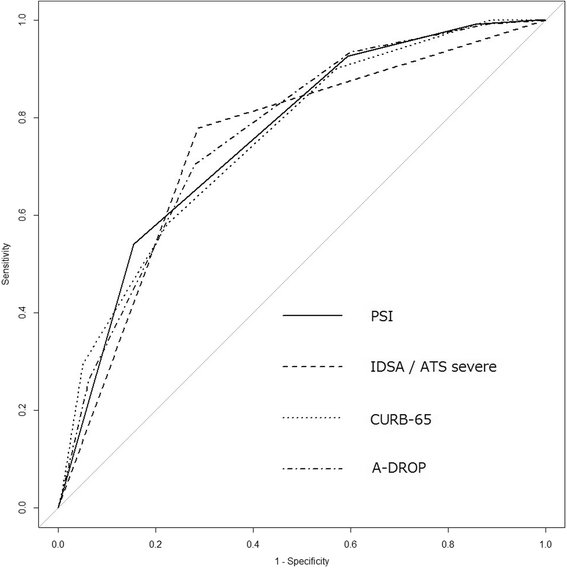Prognostic factors in hospitalized community-acquired pneumonia: a retrospective study of a prospective observational cohort
- PMID: 28464807
- PMCID: PMC5414343
- DOI: 10.1186/s12890-017-0424-4
Prognostic factors in hospitalized community-acquired pneumonia: a retrospective study of a prospective observational cohort
Abstract
Background: To date, only few studies have examined the prognostic factors of community-acquired pneumonia (CAP) defined according to the latest criteria, which excludes healthcare-associated pneumonia (HCAP). Therefore, we aimed to investigate the factors that affect prognosis, and evaluate the usefulness of existing pneumonia severity scores for predicting the prognosis of CAP.
Methods: We retrospectively analyzed patients with CAP, excluding HCAP, who were enrolled prospectively between April 2007 and February 2016. Four patients who used macrolides other than azithromycin (AZM) were excluded. We used age, sex, comorbidities, laboratory findings and antimicrobial therapy as prognostic variables. The primary outcome was 30-day mortality and secondary outcome was ICU admission. We also performed receiver operating characteristic curve analysis of Pneumonia Severity Index (PSI), Infectious Diseases Society of America (IDSA)/American Thoracic Society (ATS) severe criteria, CURB-65 and A-DROP pneumonia severity scores.
Results: Among 1834 CAP patients, mean age was 73.5 ± 14.3 years; 1281 (69.8%) were men; and 30-day mortality was 6.7% (122/1834). In total, 1830 patients were analyzed. Multivariate analysis identified age [Odds Ratio (OR): 1.04, 95% Confidence Interval (CI): 1.02-1.07], chronic obstructive pulmonary disease (COPD) [OR: 1.77, 95% CI: 1.13-2.76], malignancy (OR: 2.25, 95% CI: 1.25-4.06), body temperature (OR: 0.81, 95% CI: 0.67-0.99), respiratory rate (OR: 1.04, 95% CI: 1.01-1.07), PaO2/FiO2 ≤ 250 (OR: 3.15, 95% CI: 1.93-5.14), Alb (OR: 0.27, 95% CI: 0.19-0.39), BUN (OR: 1.01, 95% CI: 1.00-1.02), and mechanical ventilation (OR: 2.99, 95% CI: 1.75-5.12) as prognostic factors. AZM and β-lactam combination therapy significantly reduced 30-day mortality (OR: 0.50, 95% CI: 0.26-0.97). Areas under the curve of PSI, IDSA/ATS severe criteria, CURB-65 and A-DROP were 0.759, 0.746, 0.754 and 0.764, respectively.
Conclusions: Increasing age, presence of COPD and malignancy as comorbidities, hypothermia, tachypnea, PaO2/FiO2 ratio ≤250 mmHg, low Alb level, high BUN level and mechanical ventilatory support predict a worse prognosis; AZM combination therapy should be considered for CAP, excluding HCAP. All four pneumonia severity scores are useful for assessing the severity of CAP defined by the latest criteria.
Trial registration: UMIN-CTR UMIN000004353 . Registered 7 October 2010. Retrospectively registered.
Keywords: Azithromycin; Combination therapy; Community-acquired pneumonia; Prognosis; Severity score.
Figures

Similar articles
-
Pneumonia severity index class v patients with community-acquired pneumonia: characteristics, outcomes, and value of severity scores.Chest. 2007 Aug;132(2):515-22. doi: 10.1378/chest.07-0306. Epub 2007 May 15. Chest. 2007. PMID: 17505026
-
PIRO score for community-acquired pneumonia: a new prediction rule for assessment of severity in intensive care unit patients with community-acquired pneumonia.Crit Care Med. 2009 Feb;37(2):456-62. doi: 10.1097/CCM.0b013e318194b021. Crit Care Med. 2009. PMID: 19114916
-
Validation of the Infectious Diseases Society of America/American Thoracic Society criteria to predict severe community-acquired pneumonia caused by Streptococcus pneumoniae.Am J Emerg Med. 2009 Oct;27(8):968-74. doi: 10.1016/j.ajem.2008.07.037. Am J Emerg Med. 2009. PMID: 19857416
-
Simplification of the IDSA/ATS criteria for severe CAP using meta-analysis and observational data.Eur Respir J. 2014 Mar;43(3):842-51. doi: 10.1183/09031936.00089513. Epub 2013 Oct 10. Eur Respir J. 2014. PMID: 24114960 Review.
-
Making sense of scoring systems in community acquired pneumonia.Respirology. 2009 Apr;14(3):327-35. doi: 10.1111/j.1440-1843.2009.01494.x. Respirology. 2009. PMID: 19353770 Review.
Cited by
-
Clinical Presentations and Outcomes Related to Tuberculosis in Children Younger Than 2 Years of Age in Catalonia.Front Pediatr. 2019 Jun 11;7:238. doi: 10.3389/fped.2019.00238. eCollection 2019. Front Pediatr. 2019. PMID: 31245340 Free PMC article.
-
Performance of Machine Learning Algorithms for Predicting Adverse Outcomes in Community-Acquired Pneumonia.Front Bioeng Biotechnol. 2022 Jun 29;10:903426. doi: 10.3389/fbioe.2022.903426. eCollection 2022. Front Bioeng Biotechnol. 2022. PMID: 35845426 Free PMC article.
-
Azithromycin combination therapy for community-acquired pneumonia: propensity score analysis.Sci Rep. 2019 Dec 5;9(1):18406. doi: 10.1038/s41598-019-54922-4. Sci Rep. 2019. PMID: 31804572 Free PMC article.
-
Performance of A-DROP, NEWS2, and REMS in predicting in-hospital mortality and mechanical ventilation in pneumonia patients in the emergency department: a retrospective cohort study.Int J Emerg Med. 2024 Dec 27;17(1):198. doi: 10.1186/s12245-024-00792-1. Int J Emerg Med. 2024. PMID: 39731025 Free PMC article.
-
Interpretable mortality prediction model for ICU patients with pneumonia: using shapley additive explanation method.BMC Pulm Med. 2024 Sep 13;24(1):447. doi: 10.1186/s12890-024-03252-x. BMC Pulm Med. 2024. PMID: 39272037 Free PMC article.
References
-
- Mandell LA, Wunderink RG, Anzueto A, Bartlett JG, Campbell GD, Dean NC, et al. Infectious Diseases Society of America/American Thoracic Society consensus guidelines on the management of community-acquired pneumonia in adults. Clin Infect Dis. 2007;44(Suppl 2):S27–72. doi: 10.1086/511159. - DOI - PMC - PubMed
Publication types
MeSH terms
Substances
LinkOut - more resources
Full Text Sources
Other Literature Sources
Medical
Miscellaneous

